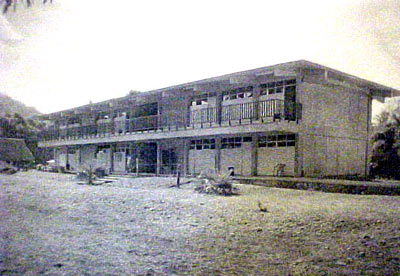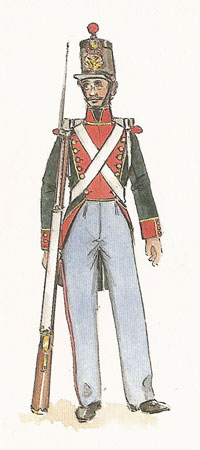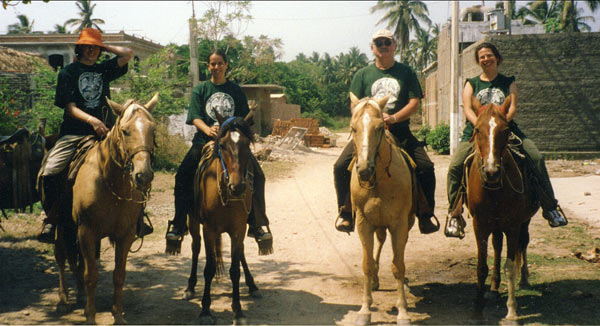|

New preparatoria school in
San Patricio/Melaque
|
A
New High School
From our work with Flavio González, we met another teacher,
Adalberto Vigil, who had a bigger project in mind. He wanted
to build a new high school, a Preparatoria, for the kids in
San Patricio/Melaque. For several years, there was a community
debate about the location of the new high school and the
battalion did its best to stay clear of the controversy. By
1999, the site was chosen and the battalion was there for the
placing of the first stone, but financing still had to be
arranged before construction could begin.
The
Battalion and Evergreen Students
By Spring 2000, I felt that the Battalion had established
itself well enough to organise a joint project with students
from my college. I organised a Spring class called 'The
Mexican Nation-State'. Evergreen students studied Mexican
Independence and the Mexican Revolution while travelling for
the month of April on the route of Pancho Villa and Emiliano
Zapata from Chihuahua to Morelos. We concluded our trip by participating in the May
Day Parade in Mexico City that, among other things, honours the struggle of the American
worker for the eight-hour working day in the late 1880s.
After one month of travel, high-school teachers Adalberto and
Rosa organised a one-month home stay in San Patricio/Melaque.
My students lived for the month of May in the homes of the
parents who wanted to build a new high school. In exchange my
students each made a donation to the school construction fund.
|

Officer of the San Patricio
Battalion
(Glenn Thompson, Irish Stamps, 1997) |
The joint project worked so well this first year that we
agreed to do this class and home stay again in Spring 2002.
In Spring 2002, I was bringing more students to Mexico for a month's study of the Mexican Revolution and to San
Patricio for another month's home stay.
As was my custom, I first delivered the $4000 in home stay
funds to the San Patricio High School Construction Fund and
then flew to Chihuahua to meet my students and begin our travels. I was supposed to
return to San Patricio with my students by early May to
participate in the opening of the new High School. The
battalion was by now the largest private donor to new High
School.
We never made it. In fact, we were expelled from Mexico on 2 May 2002.
The
Battalion and the People of Atenco
As we travelled in Mexico that April, I asked each of my students to develop a research
project that they would present to the people of San
Patricio/Melaque in their community centre at the end of May.
Two of my students were studying the ejido system of communal land ownership in Mexico. While we were travelling, they became interested in the
conflict between the Mexican federal government and the people
from an ejido called
Atenco. The people of this ejido
were resisting a federal domain decree condemning their land
for a new 11,000-acre, six -runway airport on the outskirts of
Mexico City.
Just before arriving in Mexico City to participate in the May Day Parade, we had spent four days
travelling the route of Emilio Zapata in the state of Morelos
and studying his movement's main contribution to the Mexican
Constitution of 1917, mainly the communally owned land system.
Once in Mexico City, the two students went to visit Atenco and came back with an
invitation to march with the people of Atenco in the May Day
Parade. We agreed and joined them on the broad boulevard of
Reforma and entered the narrow street of Madero from which the
parade participants pour into Mexico City's huge square, the Zócalo.
As was our practice when we marched, all my students wore
their battalion T-shirts with the symbol of the Mexican eagle
and the Celtic cross on the front and 'San Patricio, Home of
the Battalion' on the back.
A month earlier, when we had marched in Hidalgo de Parral, Chihuahua, to honour the local heroine Elissa Grissen for leading the
expulsion of General Pershing's army, we had proudly marched
just behind the Mexican army band. When we entered the
community auditorium, we were greeted as descendants of the
original battalion and applauded for our commitment to Mexico.
|

The Batallón calvary on
manoeuvres in San Patricio (May 2000)
|
When we entered the Zócalo with the people of Atenco on May
Day, we received a different welcome. The private television
company, Televisa, tried and convicted us on national
television for interfering in the internal politics of Mexico. A few of my students were carrying machetes which had been
given to them by the farmers and this made sensational
photographs in the international press.
The next day, 2 May, as we travelled toward San
Patricio/Melaque to attend the opening of the new High School
and begin our home stay, we were taken off the bus by federal
police outside Guadalajara and four hours later put on an Aeroméxico flight to
Los Angeles.
Our official expulsion papers said that we had engaged in
activities not sanctioned by our tourist visas. The
'activities' were not specified. Nevertheless, when we got
home, we were asked by college authorities and the Mexican
consulate to apologise for 'interfering in the internal
politics of Mexico', something we had not been formally charged with. We
refused.
In a written statement to both the college and Mexican
authorities, we apologised for whatever violation of Mexican
law we might have committed, but said that while we did not go
to Mexico to march with the people of Atenco, we were proud to have done
so.
Two months later in August 2002, the Mexican federal
government cancelled their plans for an airport on the Atenco
land.
The
Battalion Continues
Like the original battalion, the revived battalion ran into
some problems with a Mexican administration. However, the
Mexican tradition of hospitality and the battalion's
commitment to honouring and building links between the Irish
and the Mexicans will overcome these problems.
The newly built Kiosko remains central to the social life of
San Patricio/Melaque. The new High School has opened and
students are graduating. Some of the battalion members who
were expelled have organised a sustained book drive to provide
Spanish language literature to the new High School library.
All books are stamped with the battalion symbol. Battalion
members continue their participation in the Saint Patrick's
Day celebrations and are working on new projects with the
town. Our attachment to the people of Atenco remains. 'Land
and Liberty' is as Irish as it is Mexican.
Dan Leahy
Heroico Batallón de San Patricio
PO Box 602
Olympia, Washington 98507
(360) 352-7086
danleahy43@yahoo.com
|



